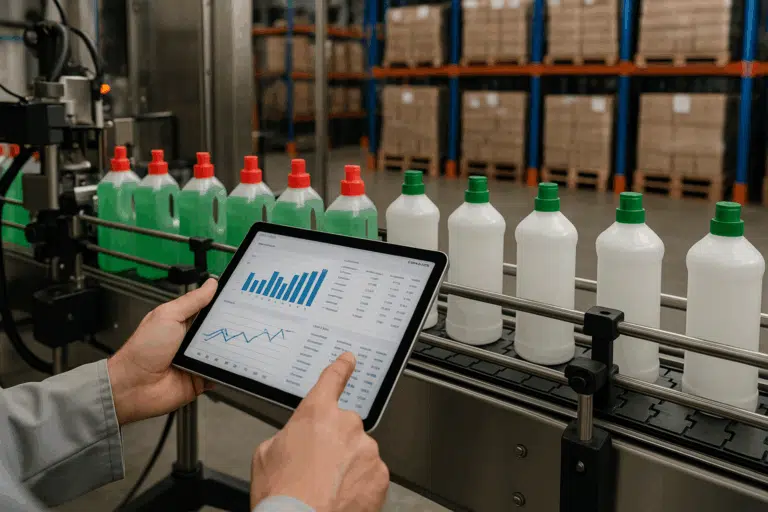At The CPCON Group, we know how important inventory accuracy strategies are for businesses. Mastering warehouse stock counting techniques is key to doing well. We’ve seen how these methods can make a big difference in how well a business runs.
Good warehouse inventory control is more than just counting items. It’s about using systems that keep stock accurate. Physical counts are important but can be hard in big warehouses. That’s why many use cycle counts, which are less of a hassle but still give good inventory info.
But are cycle counts enough to stop inventory mistakes from causing big problems? Or are there better ways to manage your stock? Using drones, RFID, and barcode scanning is now common in managing inventory. Join us as we look into inventory management best practices that help your business succeed.
Table of Contents
ToggleKey Takeaways
- Cycle counting regularizes stock accuracy without disrupting workflows.
- Innovative methods, like drone technology, enhance counting efficiency.
- Stock counting is foundational to maintaining high service levels.
- ABC analysis prioritizes inventory to refine counting frequency.
- Technology integrations are crucial for precise inventory management.
- Adaptive strategies and regular audits reaffirm market competitiveness.
Understanding the Importance of Inventory Optimization

In today’s fast-changing market, it’s hard to keep the right amount of stock. We know how key it is to manage inventory well. This helps keep business running smoothly, boosts profits, and makes customers happy.
The Role of Data Analytics in Inventory Management
Using data analytics in inventory changes raw data into useful insights. These insights help predict what customers will buy, track sales, and manage stock better. For example, data-driven methods help restock just in time, cutting storage costs and avoiding stockouts.
Also, using analytics to count stock in warehouses makes things run smoother and more efficiently.
Implications of Inaccurate Inventory on Business Operations
Wrong inventory levels cause big problems, like missing sales and wasting money on unsold items. Businesses that don’t manage their inventory well might see cash flow issues, upset customers, and higher costs. But, managing inventory well keeps the right stock on hand, builds customer loyalty, and makes operations better.
Technology like Warehouse Management Systems (WMS) is key in managing inventory. These systems use smart algorithms to predict what customers will want. This helps keep inventory levels right, cuts the chance of running out of stock, and makes managing inventory easier.
Here’s a look at how inventory management changes before and after using advanced WMS solutions:
| Aspect | Before WMS Implementation | After WMS Implementation |
|---|---|---|
| Inventory Accuracy | Low due to manual processes | High with automated tracking |
| Order Processing Time | Slower, error-prone manual entry | Fast, streamlined by automation |
| Operational Costs | Higher due to inefficiencies | Lower due to optimized processes |
| Customer Satisfaction | Inconsistent due to stock issues | Improved with reliable stock availability |
Dealing with inventory management shows us that using strong inventory solutions is crucial. It’s not just good, it’s necessary for growing a business and keeping customers happy.
Inventory Accuracy Methods: A Primer
At The CPCON Group, we stress the need for accurate inventory counting strategies and efficient stock counting procedures. These are key to great inventory management. They help businesses work better and succeed.
We push for new ways to count inventory, cutting down on manual work and boosting accuracy. For example, using Vimaan’s computer vision for cycle counting helps. It makes counting more often and more precise, changing the game in warehouse stock counting.
- An effective cycle counting program can cut the need for full annual inventory checks. This saves time and resources.
- Random cycle counting with control groups creates a strong network. It makes sure all items are checked once a year without slowing down work.
- Advanced systems like Vimaan’s can cut inventory-related checks by over 75%.
- Switching to tech-driven counting cuts down on human mistakes. This leads to better order fulfillment and happier customers.
Using accurate inventory counting strategies and efficient stock counting procedures makes inventory management better. It also makes the supply chain more agile and quick to respond. Moving to these new methods shows our dedication to improving inventory management and efficiency.
Our methods get rid of old, hard ways of counting. They make a smooth move to accurate and efficient systems. This opens the door for more improvements in inventory accuracy.
Warehouse Stock Counting Techniques: Analytics-Driven Strategies

In today’s changing warehouse world, using analytics-driven strategies is key. It helps make inventory auditing techniques better and use advanced stock counting solutions. At The CPCON Group, we use the latest tech and analysis to make warehouse stock counting techniques more precise and efficient.
We look at many factors to figure out the best number of products to keep. These include production, sales, demand, and how things move around. This careful analysis helps us make smart choices. It makes sure we have the right amount of stock for the market and our operations.
We use different types of inventory for different businesses. We manage raw materials, parts, work in progress, and finished goods carefully. This stops us from having too much or too little stock. It helps us stay cost-effective and run smoothly.
| Technique | Impact on Inventory Accuracy | Operational Benefit |
|---|---|---|
| RFID Inventory Counting | High accuracy, real-time data | Reduces counting errors, enhances tracking |
| Barcode Scanning | Fast and reliable | Speeds up the inventory count process |
| Perpetual Inventory System | Continuous real-time updates | Ensures data is always current, reduces stock discrepancies |
| Cycle Counting | Maintains ongoing accuracy | Minimizes disruption, allows for regular adjustments |
We also use advanced stock counting solutions like RFID and Gen AI for predictive analytics. This helps us adjust stock levels based on what’s happening now. It makes managing stock better, follows rules, and uses resources well.
At CPCON, we always work to improve our strategies. Every project gives us new ideas. We use these to make our inventory management better, more accurate, and cost-effective for our clients.
Optimizing Warehouse Stock Counts with ABC Analysis

At The CPCON Group, we know that managing inventory well is key. Using ABC analysis helps us use resources better in any warehouse. It sorts items by their value and how often they move. This changes how businesses handle their stock.
The Process of Conducting ABC Analysis
We start ABC analysis by sorting items into three groups. We look at their value and how often they are used. This way, we make sure we use our resources well. We focus on items that really matter to our operations.
- Identifying and listing all inventory items
- Calculating the annual demand multiplied by unit cost for each item
- Ranking items based on the total value calculated
- Classifying items into categories: A (high value), B (moderate value), and C (low value)
This detailed method helps us focus on what’s really important. It makes sure important items get the attention they need. It also helps avoid stock shortages and too much stock.
Advantages of Prioritizing Inventory with ABC Analysis
Using ABC analysis for stock counting makes managing stock better. It helps us focus on what’s really important. This leads to many benefits:
- Reduced inventory handling costs by focusing on high-value items
- More efficient inventory audits by looking at what matters most for money
- Better stock handling and space use by putting high-priority items in the best spots
| Category | % of Inventory | Contribution to Inventory Value |
|---|---|---|
| A – High Value | 20% | 70-80% |
| B – Moderate Value | 30% | 15-25% |
| C – Low Value | 50% | 5-10% |
ABC analysis also helps with planning security, where to keep stock, and training staff. It’s a key method for warehouse stock counting techniques.
Knowing where inventory is and focusing on key items makes stocktaking better. The CPCON Group uses ABC analysis to help companies manage stock better. This leads to better results and more efficient operations.
Leveraging Demand Forecasting for Stock Control

At The CPCON Group, we know how important demand forecasting is for managing stock. It helps us plan better and avoid too much or too little stock. This is key to keeping things running smoothly.
We use data from past sales, market trends, and what customers like to predict what they’ll want next. This helps us keep the right amount of stock. It also helps us use inventory accuracy methods well, so we’re ready for any changes in the market.
- By knowing what customers will want, we can work better with suppliers and get things faster.
- We use our resources better, so we don’t waste anything and make sure we have enough stock.
- We plan our money better because we know what we’ll sell, which helps us use our budget well.
Good inventory management means using advanced forecasting that looks at the latest market data and uses smart analytics. We use the latest technology and smart forecasting to help our clients make better choices and adapt to changes.
Using advanced forecasting to manage stock doesn’t just reduce risks. It also saves money and makes customers happier because we’re always ready with the stock they need. As we keep improving, forecasting and managing stock well is key to doing great in inventory management.
The Strategic Value of Safety Stock Management
At The CPCON Group, we focus on safety stock management as a key part of our efficient inventory management plans. Keeping the right amount of safety stock helps us avoid running out of stock. This keeps our supply chain strong against changes in demand and delivery times.
This strategy makes sure customers are happy by always having what they need. It also helps keep costs down by making supply operations more stable.
| Parameter | Detail |
|---|---|
| 50% Rule | Target safety stock level at about 50% of maximum inventory to effectively shield against unexpected stockouts. |
| Z Formula Application | Uses Z-score for normal distribution to calculate safety stock based on desired service level and variability in lead time and demand. |
| Calculation Frequency | Safety stock levels re-evaluated quarterly, more often in volatile markets. |
| Factors Influencing Safety Stock | Demand and lead time variability, desired service levels, supply chain disruptions, and economic factors must be considered. |
We use the latest warehouse stock counting techniques to make sure our safety stock strategies work well. For example:
- Method 1: Safety Stock = (Max Lead time * Max Demand) – (Average Lead time * Average Demand)
- Method 2: Safety Stock = (Average Daily Demand * Maximum Lead time) – (Average Lead time * Average Daily Demand)
This method follows the best practices in the industry but is also customized for our clients’ needs. We look at demand changes, service level goals, and lead time uncertainty to make our safety stock formulas. This ensures we hold the right balance between costs and service efficiency.
By using these strategic and calculated methods in safety stock management, we make our business more resilient. Efficient inventory management becomes a key advantage for us. This focus on precision and planning shows The CPCON Group’s leadership and innovation in logistics.
Evolving the Inventory Audit with SKU Rationalization

At The CPCON Group, we know how hard it is for businesses to handle more SKUs. SKU rationalization helps by making inventory management better. It looks at each SKU’s cost and how it helps the business. This way, companies can pick which items to keep and which to drop.
Using SKU rationalization makes managing inventory easier and improves optimized warehouse stock counting. With fewer SKUs, businesses can work better, save money, and guess demand better. This leads to selling more of what matters and saving money on slow items.
Some numbers show why this is so important: 80% of sales come from just 20% of SKUs. Also, 80% of inventory is slow-moving items that use a lot of money. These facts show why SKU rationalization is key in managing inventory well.
| Impact Area | Effect of SKU Proliferation | Benefits of SKU Rationalization |
|---|---|---|
| Sales Optimization | Only 20% of SKUs drive 80% of sales, higher SKU counts do not necessarily equate to higher sales. | Focuses on high-performing SKUs, improves sales efficiency. |
| Warehouse Efficiency | Increased complexity and time in handling large variety of SKUs. | Streamlined operations, improved stock management. |
| Cost Management | Higher storage and operational costs due to excess, slow-moving stock. | Reduced carrying costs, enhanced allocation of resources. |
| Fulfillment Efficiency | Inefficient supply chain from constant SKU additions, impacting delivery times. | Increased order accuracy and shorter order cycle times. |
To make SKU rationalization work, review your inventory with current sales data and market trends. This stops old stock from going to waste. It makes sure your stock matches what people want, making every product count.
At The CPCON Group, we use data analytics to make SKU rationalization powerful. We help businesses turn their inventory needs into strategic assets. This makes optimized warehouse stock counting key for doing well. It ensures inventory is managed for efficiency and growth.
Innovative Inventory Count Methods: RFID Technology

At CPCON, we aim to make warehouse operations better by using new ways to count stock. Over the last 25 years, we’ve become experts in RFID systems. These systems are key for counting stock accurately. RFID technology works well with current warehouse systems, giving real-time data without the need to see the item directly. This is a big plus over old barcode systems.
Integrating RFID for Enhanced Inventory Accuracy
Using RFID in counting stock makes it automatic. This cuts down on manual work and mistakes. It makes counting more accurate by up to 13% than old ways, saving time and making things run smoother. Plus, RFID tags are affordable, costing just 5 to 15 U.S. cents each.
Comparative Analysis: RFID vs. Traditional Counting Methods
Old ways of counting take a lot of work and add a lot to costs, making up 50-80% of costs in warehouses. RFID systems cost more at first, $1000 to $3000 per reader. But, they save money by cutting down on labor, reducing stock mistakes, and making orders go out faster.
| Feature | RFID | Traditional Methods |
|---|---|---|
| Initial Cost | $1000 – $3000 per reader | Minimal |
| Accuracy Improvement | Up to 13% | Limited by manual errors |
| Data Capture | Automatic | Manual |
| Operational Efficiency | Enhanced | Varies with workforce efficiency |
| Cost Savings | Significant over time | Higher long-term costs |
As we keep using RFID technology, we see a lot more potential for new ideas. These new trends will likely change how we manage stock even more. By using advanced RFID systems, CPCON helps its clients stay ahead in technology. They get real-time improvements in managing stock and making things run better.
Barcode Scanning: Speeding Up the Inventory Count Process
At The CPCON Group, we’ve made our warehouse stock counting better over years. We use advanced tools like barcode scanning to change how businesses manage their stock. Barcode scanning makes counting faster and cuts down on mistakes, making things more efficient.
Using barcode scanning and efficient counting has helped many of our clients move from old ways to new, better methods. This tech makes capturing data quicker and more reliable. It helps check stock levels fast and accurately.
Barcode scanning technology can reduce human error and save time during inventory counts, leading to a more streamlined and efficient audit process.
- Reduction of human error through automatic data entry
- Significant time savings during inventory audits
- Seamless integration with inventory management software
Companies using these technologies often do fewer full inventory counts. They use cycle counts more often. This makes things more accurate and doesn’t disrupt daily work, which is key for big companies.
| Feature | Benefit |
|---|---|
| Real-time SKU tracking | Immediate visibility into inventory levels and movement |
| Blind count capabilities | Enhanced accuracy by preventing counting bias |
| Barcode and QR code integration | Simplifies item logging and categorization |
| Mobile scanning | Enables on-the-go auditing across multiple locations |
Using barcode scanning and efficient counting not only makes handling inventory better. It also sets a strong base for accurate data analysis. This helps make better business decisions. Our work with clients like Sortly shows how this tech can change things for the better. By using these tools, companies can make sure their inventory systems are strong and can adapt to changes in the market.

Implementing a Perpetual Inventory System for Real-Time Tracking
We know how key a perpetual inventory system is for today’s warehouses. It lets you keep an eye on stock levels all the time. This gives you real-time inventory data that helps you make quick decisions and work better.
Adding a perpetual inventory system to your warehouse makes things run smoother. It also gives you deep insights into how each item moves. With automatic updates after sales or buys, you always have the latest stock info. This cuts down on stock mistakes a lot.
How Real-Time Data Transforms Stock Management
Switching to a perpetual system is a big step up for businesses. With real-time inventory data, you don’t have to worry about big stock issues. You can spot and fix problems right away.
This is super useful for places with lots of sales or where keeping an eye on stock is crucial. The perpetual inventory system keeps sending you updates. This helps with better planning, lower storage costs, and quick responses to market changes. Using tech like RFID and IoT with this system makes stock info even more reliable.
But, starting this system has its challenges. You’ll need to spend money on software and training, and keep it running. Still, the big wins like better work flow and meeting customer needs make it a smart choice for any business.
In the end, going to a perpetual inventory system is a big win. It uses real-time data to make managing stock better. It helps businesses stay ahead in a fast-changing market. For those wanting fewer mistakes and more accurate stock, a perpetual system is a smart move towards doing things better.
Efficient Stock Counting Methods: Embracing the Just-In-Time Model
At The CPCON Group, we’ve seen how the Just-In-Time inventory model changes inventory management. This method cuts down on holding costs and improves cash flow. It’s all thanks to our focus on lean inventory practices.
Using Just-In-Time inventory means planning carefully. We make sure goods arrive just when they’re needed. This cuts down on waste and stops unnecessary stockpiling. It saves resources and supports sustainable business.
Reducing Waste with Lean Inventory Practices
Lean inventory practices are key to being efficient and cutting waste. Our methods eliminate activities that don’t add value. We make sure every item has a purpose and a timeline for use.
We use advanced stats and warehouse software to improve our inventory. Here’s how we blend cycle counting with Just-In-Time to keep things accurate and smooth:
| Method | Description | Impact on Just-In-Time |
|---|---|---|
| ABC Analysis | Focuses on counting high-value items more frequently. | Ensures critical stock is always aligned with production needs. |
| Cycle Counting | Regular inventory checks without full shutdown. | Minimizes disruptions and maintains continuous flow. |
| Usage-based Analysis | Ranks inventory by movement frequency. | Keeps fast-moving items in sync with demand patterns. |
| Hybrid Analysis | Combines statistical analysis with experiential adjustments. | Adapts to real-time data for better stock positioning. |
Using Just-In-Time and lean inventory practices cuts waste and makes supply chains more agile. At The CPCON Group, we’re all about these strategies. We help our clients get and keep top inventory efficiency.
Inventory Control Techniques: The Role of FIFO and LIFO
For over 20 years, The CPCON Group has been a leader in inventory management. We use top warehouse stock counting methods to help various industries. FIFO (First-In, First-Out) and LIFO (Last-In, First-Out) are key strategies we use. They help control inventory and affect financial reports.
FIFO is known for its logical way of managing stock. It uses the oldest products first, which is great for items that don’t last long. This method helps avoid waste and keeps costs accurate, leading to more profit and taxes in inflation.
LIFO is different but also has its perks, especially in industries with changing costs. It uses the latest inventory costs to match current market prices. This is good for industries like oil and gas or fashion, where prices change often. LIFO can lower net income and taxes.
But, LIFO isn’t used worldwide because it’s not accepted by International Financial Reporting Standards (IFRS). FIFO is accepted everywhere.
| Technique | Benefits | Industry Suitability | Financial Impact |
|---|---|---|---|
| FIFO | Reduces obsolescence, aligns with natural product flow | Perishable goods, any standard inventory | Increases net income and tax liability |
| LIFO | Costs aligned with current prices, tax benefits | Oil and gas, fashion, and other fluctuating markets | Lower net income, reduced tax burden |
Choosing between FIFO and LIFO depends on your industry’s needs and tax rules. At The CPCON Group, we help clients make the best choice. We make sure their inventory methods work well with their goals.
Advanced Stock Counting Solutions: The Impact of Gen AI
Inventory management has changed a lot over the years. Now, we use advanced tech like Gen AI to make managing stock better. At The CPCON Group, we use these new tools to keep up with fast-changing markets.
By adding Gen AI to our stock counting, we can use predictive analytics. This helps us adjust stock levels before we need to. It cuts down on costs and helps avoid having too much or too little stock.
Our main goal with Gen AI is to make predictive analytics more accurate. It looks at past data and market trends to guess what we’ll need in the future. This means businesses can have the right products ready for customers.
From Predictive Analytics to Smart Inventory Decisions
Using Gen AI helps us make smarter stock choices quickly. Predictive analytics is key to planning for the future. It helps us prepare for things like seasonal changes and sales events.
AI makes complex decisions easier, keeping our stock levels just right. This keeps our supply chain smooth and ready for changes in the market. It’s important for staying ahead and succeeding in business.
In short, moving to Gen AI and predictive analytics is changing how we handle inventory and supply chains. At The CPCON Group, we’re leading the way to a future where managing stock is smart and proactive.
Inventory Management Best Practices for Accurate Counts
At The CPCON Group, we know keeping inventory accurate is key. We use inventory management best practices to get near-perfect accuracy. We train our employees well and use the latest tech like RFID and barcode scanners for effective warehouse inventory counting.
Following a structured way to count warehouse stock is also vital. It makes cycle counts more efficient. This approach helps us be more accurate and cuts down on mistakes that can lead to losing stock and write-offs.
Training Employees on Efficient Counting Procedures
Proper training helps our team count inventory well. We make sure our staff knows how to use the latest tech and follow the right steps for inventory management. We also keep learning about new trends in counting to stay ahead.
Improving Accuracy through Technology Integration
Using advanced tech is key to better inventory control. At The CPCON Group, RFID and better barcode scanners have changed the game. They help track inventory in real-time and cut down on manual counting errors. Learn more about how technology helps with accurate cycle counting.
With technology and good training, we keep inventory errors low and hit an accuracy rate near 99.6%. This careful method helps us track and manage our inventory well. It makes our operations more efficient and keeps our clients happy.
Conclusion
The CPCON Group is proud to celebrate over 25 years of leading in inventory control. We’ve worked hard to improve warehouse stock counting techniques. Our use of advanced RFID technology shows our focus on being precise and moving forward.
We lead in efficient stock counting methods like cycle counting and Gen AI. Cycle counting is key for many companies. It helps us find and fix inventory problems fast, keeping our processes smooth.
Choosing the right counting method depends on each business’s needs. The CPCON Group offers both full counts and cycle counting. We make sure our methods work best for our clients.
The key to inventory control techniques is using them smartly in each business’s setting. Our team combines deep knowledge and new tech for top-notch service. We help our clients keep their inventory in check for growth and profits.
The future of inventory is about being accurate, efficient, and quick. At The CPCON Group, we’re all about leading with the best solutions. We promise to keep our clients ahead with our expertise and technology.
FAQ
What are the key strategies for improving inventory accuracy?
Key strategies include using analytics for stock counting and doing regular inventory checks. Use ABC analysis for sorting items, forecast demand, and manage safety stock well. Also, use RFID, barcode scanning, and perpetual inventory systems to boost accuracy.
How does RFID technology improve warehouse stock counts?
RFID technology tracks inventory in real-time and accurately. It lets you monitor stock without manual scanning. This cuts down on labor costs and mistakes from old counting ways.
What is ABC analysis in inventory management?
ABC analysis sorts inventory into three groups (A, B, C) by value and use. It helps businesses focus on the most valuable items. This optimizes stock levels and improves inventory control.
Why is demand forecasting important for inventory management?
Demand forecasting is key for predicting sales and matching inventory levels. It lowers the chance of running out of stock or having too much. This ensures the right stock is available for customers.
How does a perpetual inventory system work?
A perpetual inventory system updates stock records as sales and purchases happen. It links with sales and buying platforms. This gives a clear view of stock levels and helps in making better decisions.
What are the benefits of implementing a Just-In-Time (JIT) inventory model?
JIT inventory models keep stock levels low, cutting storage and holding costs. This reduces waste, improves cash flow, and keeps products fresh. It’s great for industries like food or fashion.
Can you explain the difference between FIFO and LIFO?
FIFO (First-In, First-Out) sells the oldest stock first, good for perishables to avoid waste. LIFO (Last-In, First-Out) sells the newest stock first, matching current costs with sales during inflation.
What impact is Gen AI having on inventory management?
Gen AI brings advanced predictive analytics to inventory management. It helps businesses predict stock needs more accurately. This optimizes inventory to match consumer demand and aids in strategic decisions.
What are the best practices for training employees in inventory management?
Best practices include thorough training on new counting methods and using tech like RFID and barcode scanners. Keep staff updated on system and process changes to ensure they can do accurate inventory counts.
How does technology integration improve inventory accuracy?
Using tech like RFID and barcode scanners with inventory systems boosts accuracy. It cuts down on manual errors, gives real-time updates, and makes audits easier.
Source Links
- What is Inventory Counting? — Gather AI – https://www.gather.ai/blog/what-is-inventory-counting
- Warehouse Operations: Optimizing the Cycle Counting Process – https://valleydist.com/2747/warehouse-operations-optimizing-the-cycle-counting-process/
- Warehouse Inventory Management | 2024 Guide – https://www.autostoresystem.com/insights/guide-to-inventory-management
- Inventory Optimization – https://www.shipbob.com/inventory-management/inventory-optimization/
- Importance of Inventory Management in Warehousing | IPAK – https://ipak.com/importance-of-inventory-management-in-warehousing/
- No title found – https://dclcorp.com/blog/inventory/physical-inventory-count/
- What is Cycle Counting and How Best to Scale It – VIMAAN – https://vimaan.ai/resources/blog/why-cycle-counting-is-used-and-how-best-to-scale-it/
- Manufacturing Inventory Accuracy Counts | Carr, Riggs & Ingram CPAs and Advisors – https://cricpa.com/insight/manufacturing-inventory-accuracy/
- Different Inventory Count Techniques (7 methods) – CPCON – https://cpcongroup.com/different-inventory-count-techniques/
- Warehouse Management: Inventory Analysis Approaches and Best Practices – https://lingarogroup.com/blog/warehouse-management-inventory-analysis-approaches-and-best-practices
- Inventory counting: doing it quickly and effectively – https://www.mecalux.com/blog/inventory-counting-quick-effective
- How ABC Analysis Supports Inventory Control Best Practices – https://www.logiwa.com/blog/abc-analysis-inventory-control
- What is ABC Analysis and How is it Used in Warehousing? – Shipedge – https://shipedge.com/blog/inventory-management/abc-analysis/
- Demand Forecasting for Supply Chains: How to Predict & Plan – https://www.netstock.com/blog/demand-forecasting-for-supply-chains-how-to-predict-plan/
- Greater Inventory Control Begins with Demand Forecasting – https://www.cleverence.com/articles/business-blogs/greater-inventory-control-begins-with-demand-forecasting/
- Inventory forecasting through Demand and Supply – https://www.linkedin.com/pulse/inventory-forecasting-through-demand-supply
- Safety Stock: Definition, Importance & Calculation – https://www.amsc-usa.com/blog/safety-stock-warehouse/
- Safety Stock: How to Calculate and Best Practices – https://ware2go.co/articles/safety-stock/
- How SKU Analysis Helps DCs Assess the Impact of SKU Proliferation on Their Operation – https://www.conveyco.com/blog/sku-analysis-sku-proliferation/
- What is SKU Proliferation and How to Keep it in Check – https://www.shipbob.com/blog/sku-proliferation/
- Using RFID for Inventory Management: Pros and Cons – Camcode – https://www.camcode.com/blog/using-rfid-for-inventory-management-pros-and-cons/
- From Chaos to Clarity: The Impact of RFID in Warehouse Operations – https://www.getfactorysense.com/resources/from-chaos-to-clarity-the-impact-of-rfid-in-warehouse-operations
- Inventory Counting Companies: Why CPCON? – CPCON – https://cpcongroup.com/inventory-counting-companies/
- Physical Inventory Counting: Industry Standards for Counting Inventory – https://www.fcbco.com/blog/physical-inventory-counting-best-practices
- What Is the Best Way to Count Inventory? | Sortly – https://www.sortly.com/blog/what-is-the-best-way-to-count-inventory/
- Perpetual inventory system: how real-time data helps improve stock management – https://redstagfulfillment.com/perpetual-inventory-system/
- How to Use a Perpetual Inventory System for Your Ecommerce Business – https://www.shipbob.com/blog/perpetual-inventory-system/
- Perpetual Inventory System – https://www.investopedia.com/terms/p/perpetualinventory.asp
- How to Maintain Optimal Stock Levels: Your Warehouse Guide – https://claruswms.co.uk/how-maintain-optimal-stock-levels/
- Warehouse Cycle Counting and Inventory Management – https://www.logiwa.com/blog/cycle-counting-inventory
- FIFO vs. LIFO Inventory Valuation – https://www.investopedia.com/articles/02/060502.asp
- Inventory Control Methods: FIFO, LIFO, and ABC Analysis Explained – https://mltechsoft.com/insights/blog/inventory-control-methods-fifo-lifo-abc-analysis
- Inventory Management Methods: FIFO vs. LIFO – https://www.businessnewsdaily.com/5514-fifo-lifo-differences.html
- Utilizing AI for Efficient Inventory Management Systems – https://www.netstock.com/blog/utilizing-ai-for-efficient-inventory-management-systems/
- AI in inventory management: An overview – https://www.leewayhertz.com/ai-in-inventory-management/
- Inventory Accuracy – https://www.shipbob.com/inventory-kpis/inventory-accuracy/
- Cycle Counting in Warehousing: Best Practices – https://www.cadretech.com/blog/cycle-counting-in-warehousing-best-practices/
- What are cycle counts? | Pallite Group – https://pallitegroup.com/us/news/cycle-counts-and-warehouse-storage/
- What are the Pros and Cons of Full Inventory Counting? – https://monarch-inv.com/what-are-the-pros-and-cons-of-full-inventory-counting-kansas-city/
- Taking a Physical Inventory Count: 10 Practical Tips to Make the Task a Whole Lot Easier – https://www.lightspeedhq.com/blog/taking-physical-count-inventory/



























